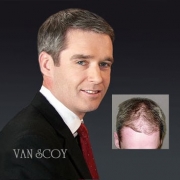There are often times when you come across a young patient that is highly interested in having a hair transplant procedure. A young patient refers to an individual that is 25 years of age or younger. Great care must be taken in considering someone at this age for a hair transplant. Young patients must be made aware that hair is transplanted in bald or thinning areas, the hair loss of their existing native hair will continue and new thinning areas may be created which will require further procedures in the future.
 Young patients are divided into 3 main types:
Young patients are divided into 3 main types:
TYPE 1: Ηair loss in the temporal areas (Norwood Class 2 or 2A)
A person in with this type of hair loss will begin to lose hair on their temples and they are often worried to replace the lost hair.
This is sometimes not the best solution. Hair loss will continue and by having a hair transplant into the temporal areas, it is possible that soon enough the hairline will begin to recede and the hair behind the transplanted temporal area will start to receding too. This can leave young patients with two patches of hair on the left and right temple. If that happens then the patient has no other options but to proceed with further surgeries to replace those empty areas or they would be left with a strange and unnatural look. It is important to examine the present condition of donor and recipient areas and a look at the family history of hair loss. This will help approximately predict the Norwood Scale that he might end up at in the future.A decision can be made to proceed once we know all the information.
TYPE 2:
- Receding hairline & temporal areas (Norwood Class 3)
- Receding hairline & temporal areas and crown (Norwood Class 3V)
- Receding hairline & temporal areas and top (Norwood Class 4 or 4A)
This type of young patient has reached a stage where they feel they are losing their youth, and there is a significant amount of hair that will be needed to replace the hair in these areas.
In this type of case, the family history of hair loss has to be examined in order to predict the final stage of baldness that could be reached. We also need to investigate the quality of follicular units in the donor area. If it can be determined that the young patient is a potential Norwood Class 7, it is better to avoid the hair transplant surgery as the donor area may not offer enough to cover the potential baldness. If the patient is found to be a potential Norwood Class 5 or 6 then a hair transplant is possible but the individual must understand the limitations regarding hair density. If a high density is used to cover the front and crown areas, then there may not be enough in the donor area to maintain this high density with future balding. Because of this, a more conservative approach needs to be taken.Usually, young patients have a higher expectation as they have just recently lost their hair and are not willing to settle for anything less than what they once had. Before a hair transplant can be performed the patient must have realistic expectations or they will be unsatisfied with the results.
TYPE 3:
- Receding top and crown (Norwood Class 5)
- Receding top, crown, and back (Norwood Class 6)
This type of young patient has to have a lot of caution.This is the type of person that very well may end up in a high class 7 and a hair transplant is not recommended. We need to carefully examine the hair loss history from mother and fathers side and identify whether the patient has reached the final stage of hair loss or if the potential for hair loss in the future is possible. This is what when we would have them look into hair replacement as a solution. They can only replace their hair with a mature hairline, low density with the help of donor beard hair. Another option is to leave the crown area uncovered but still have a natural look.
These cases are looked at individually and advice is given according to parameters such as:
- final expected stage of hair loss,
- the density of the remaining donor,
- quality of follicular units in the donor
- and expectations.
At Van Scoy Hair Clinics we are very concerned about the correct approach to all of our patients and especially the young ones. We are committed to giving the correct advice.


